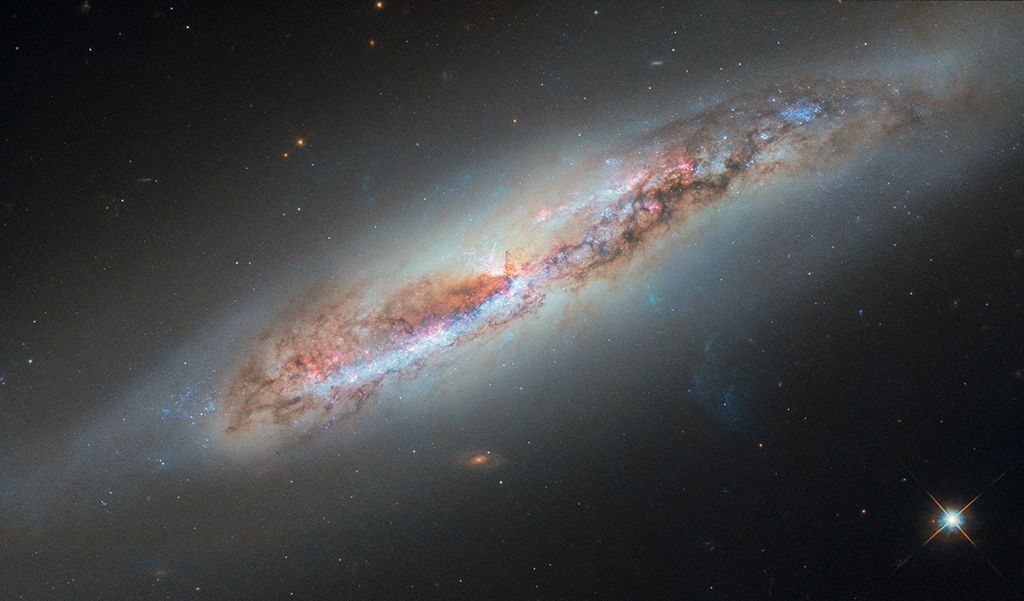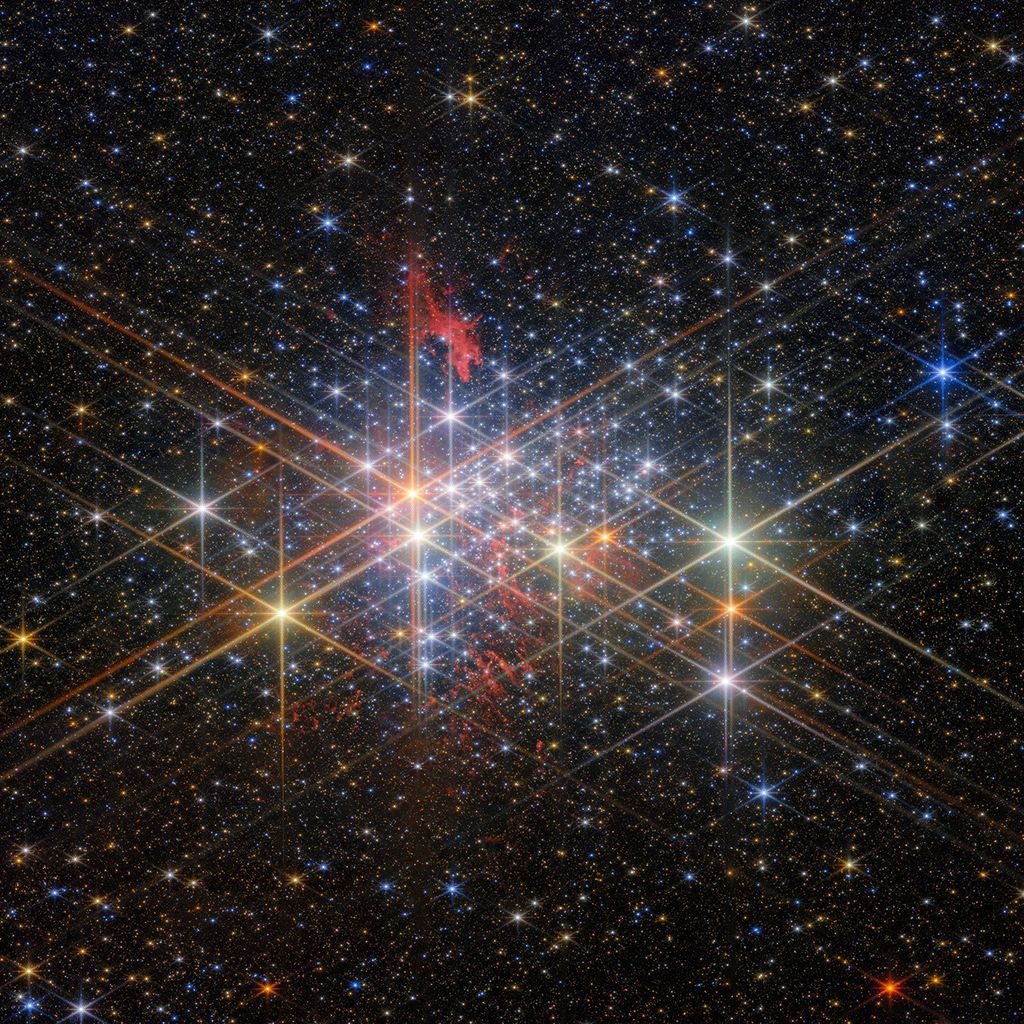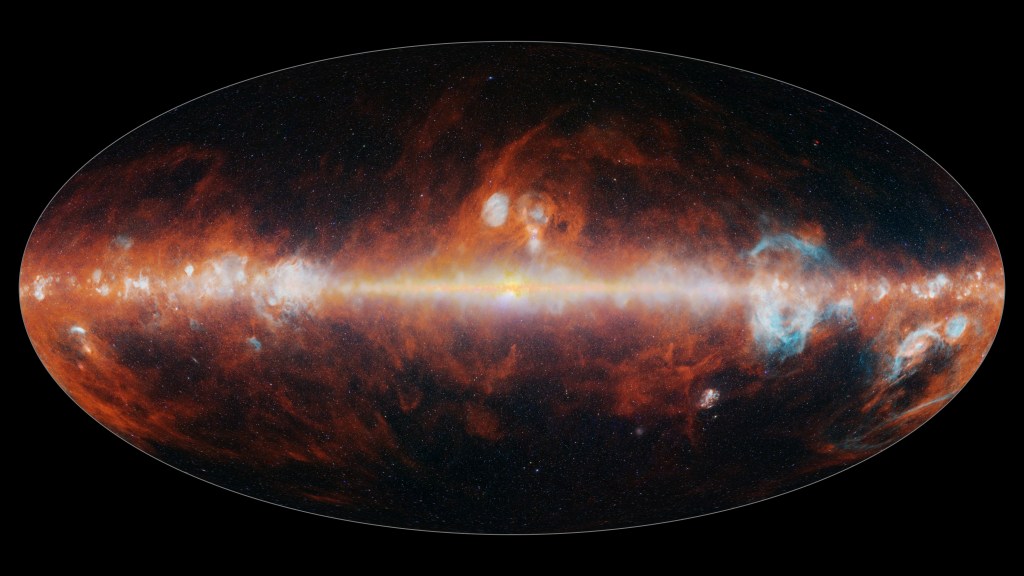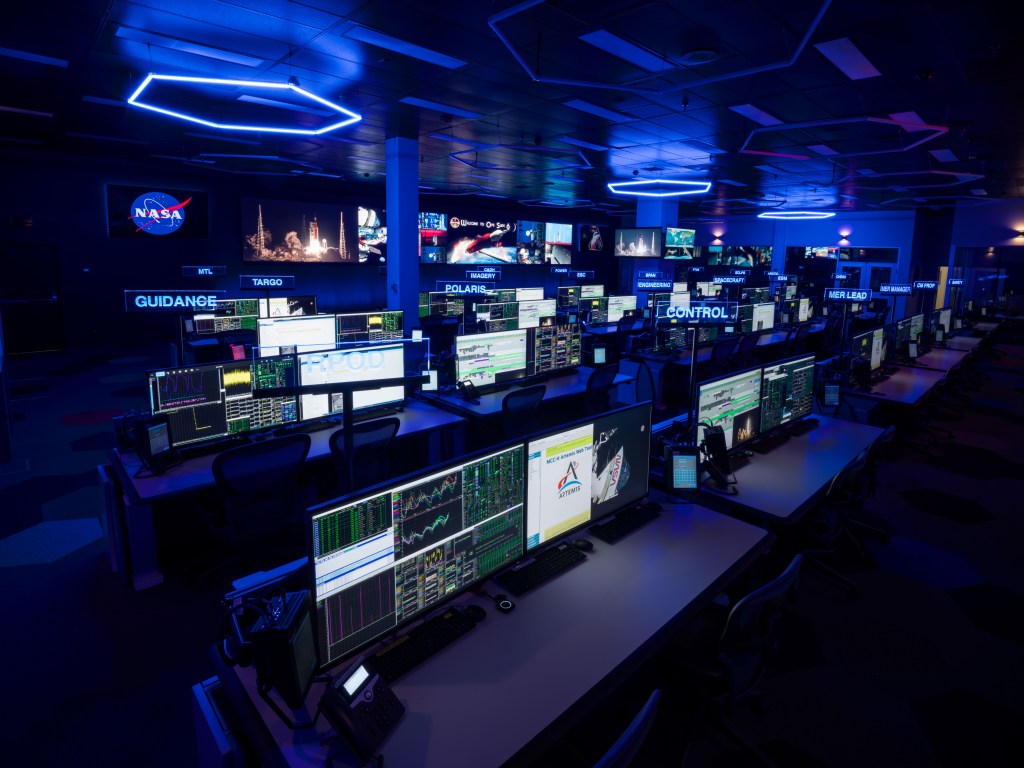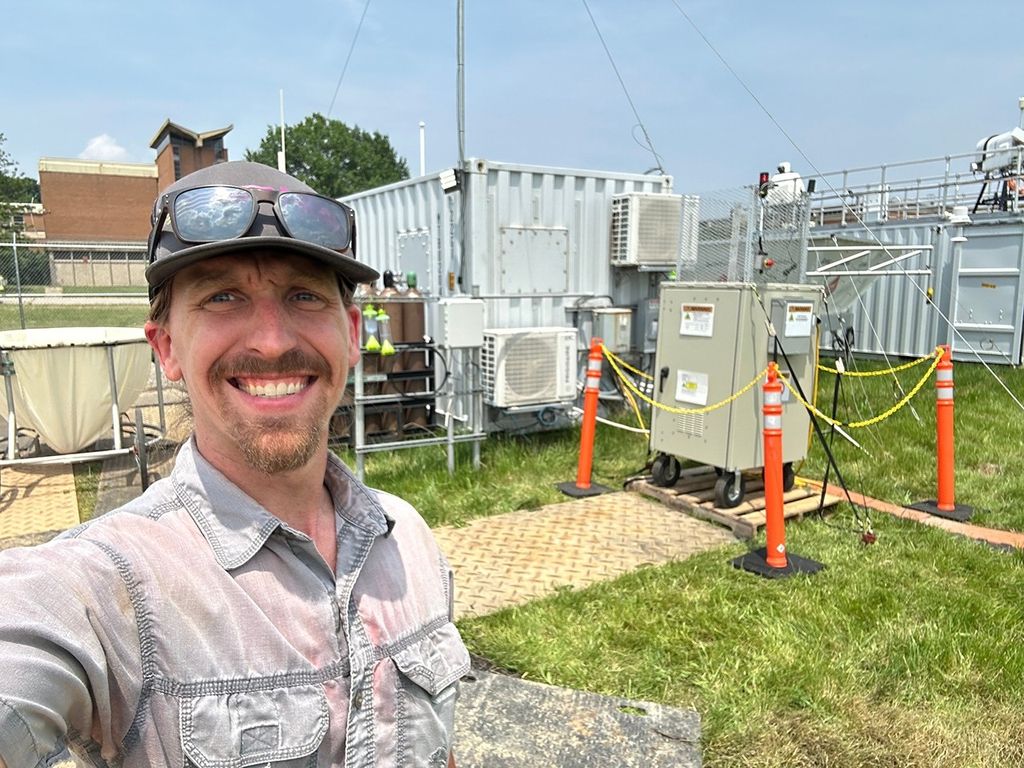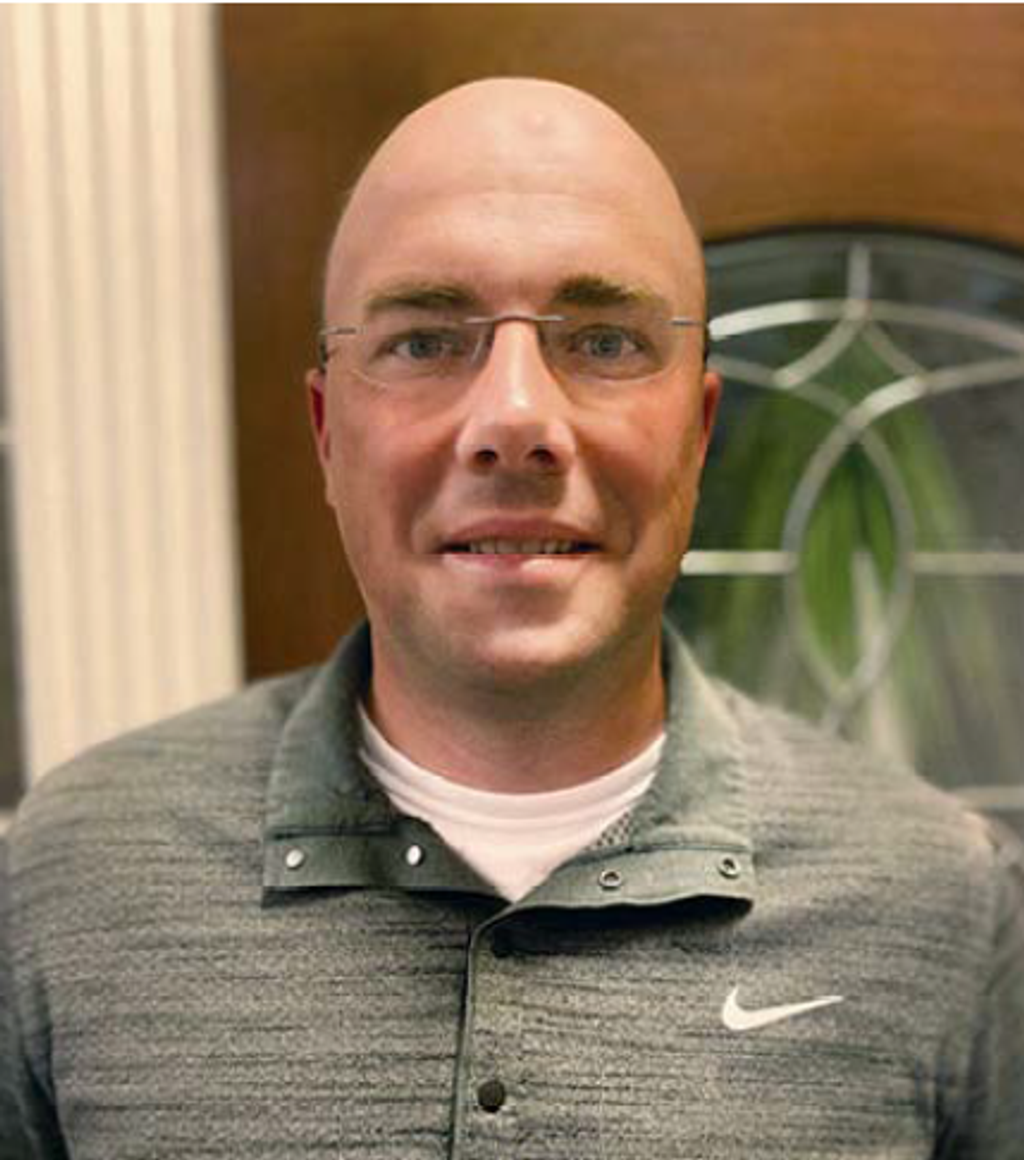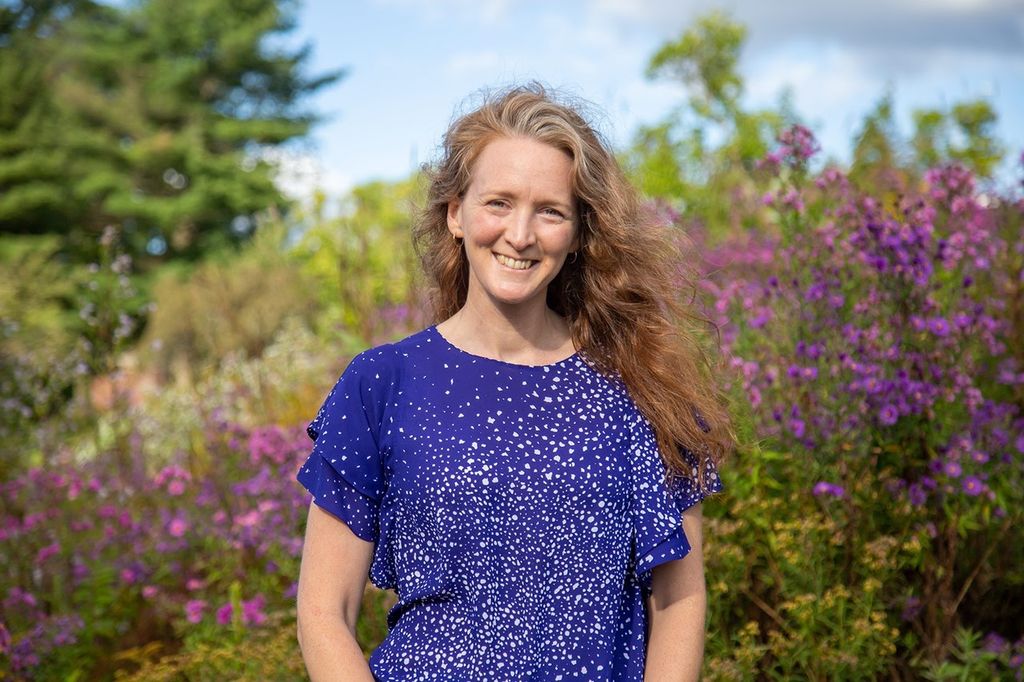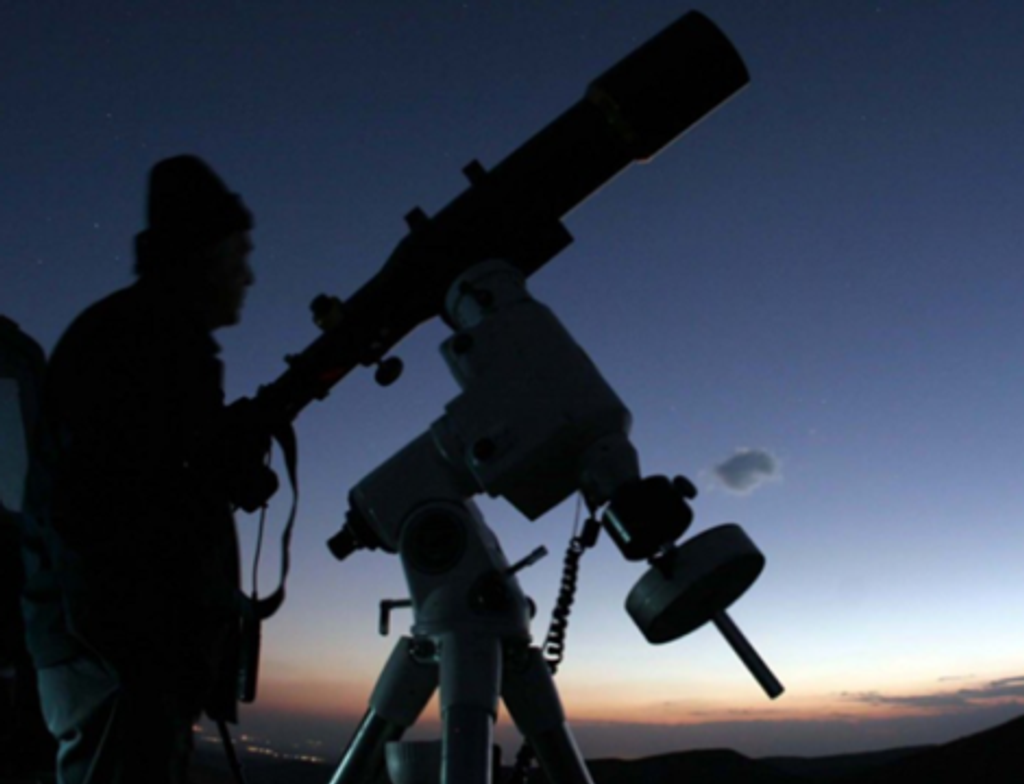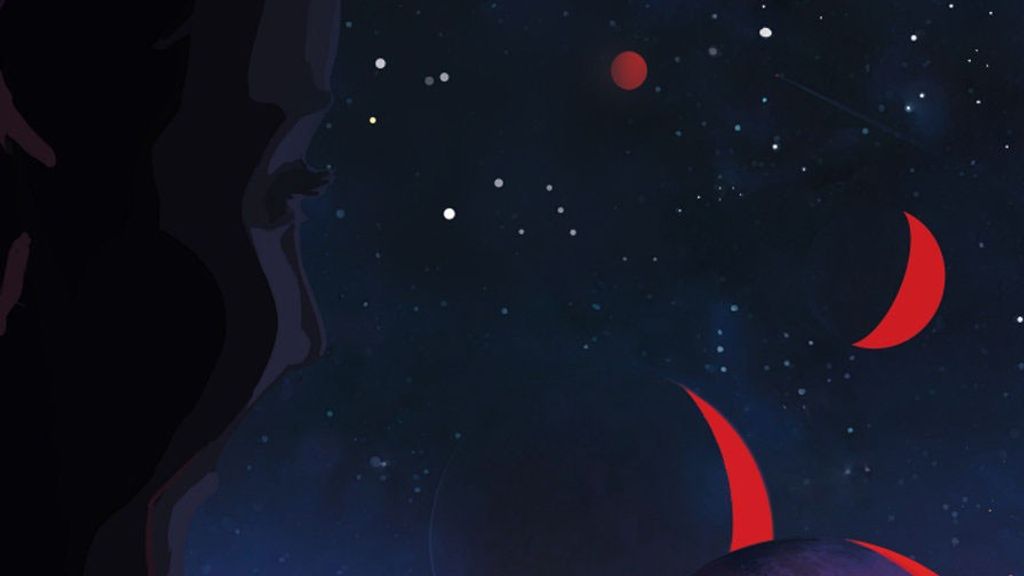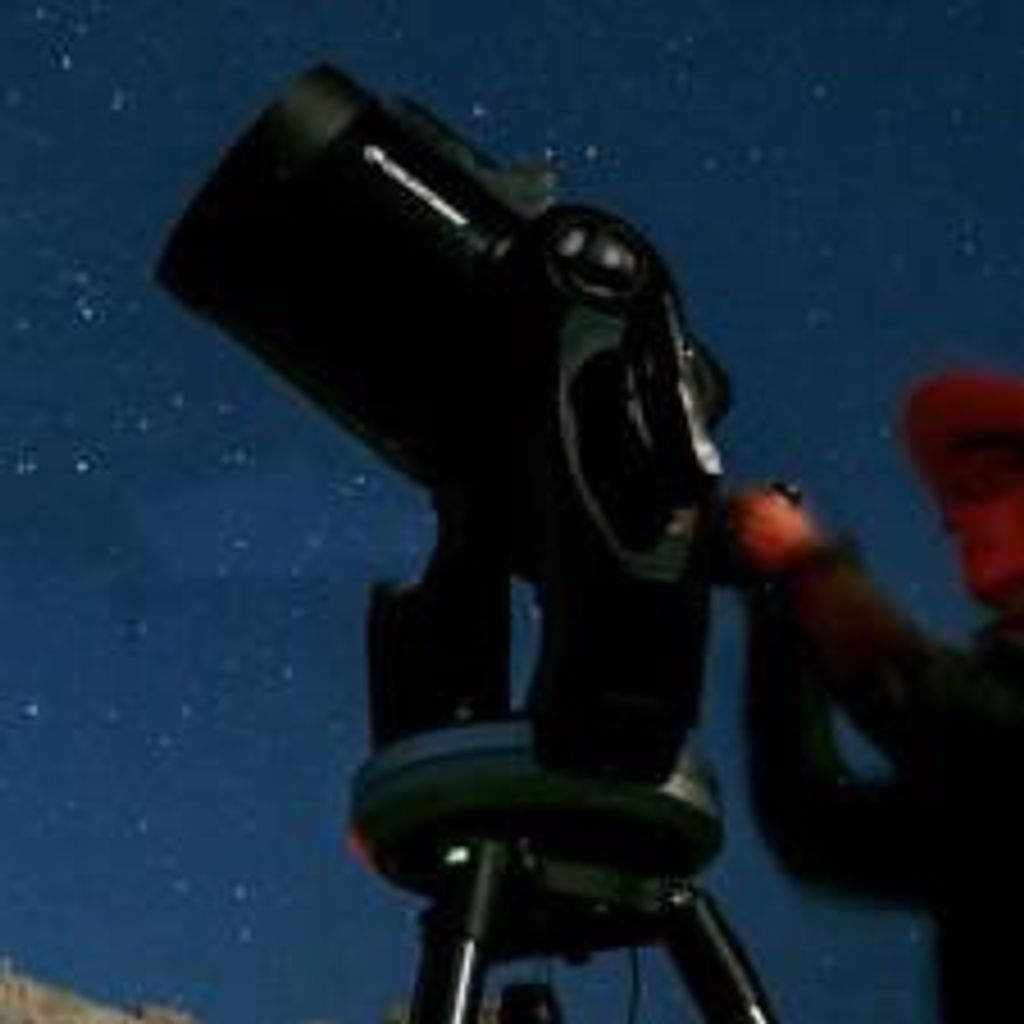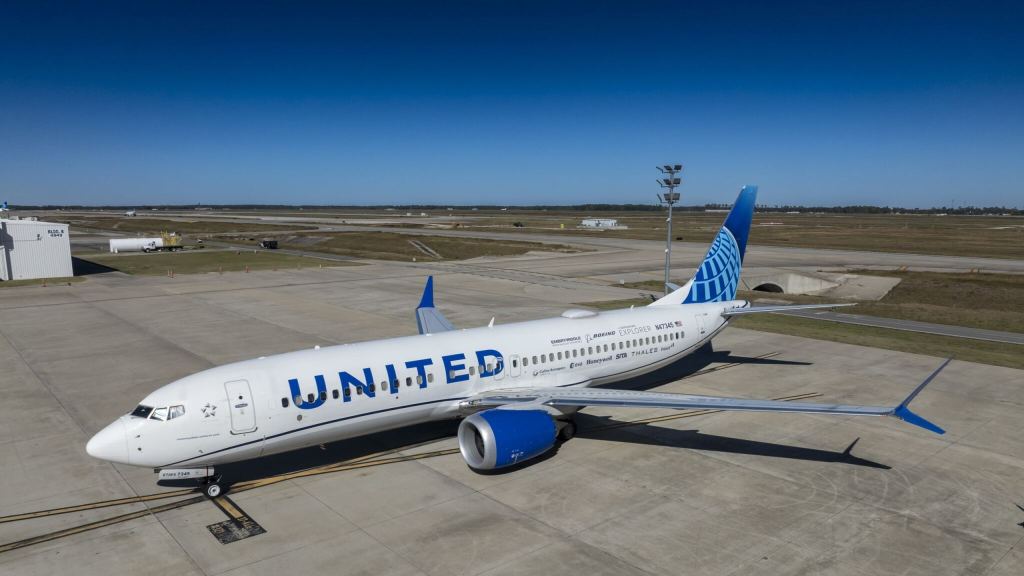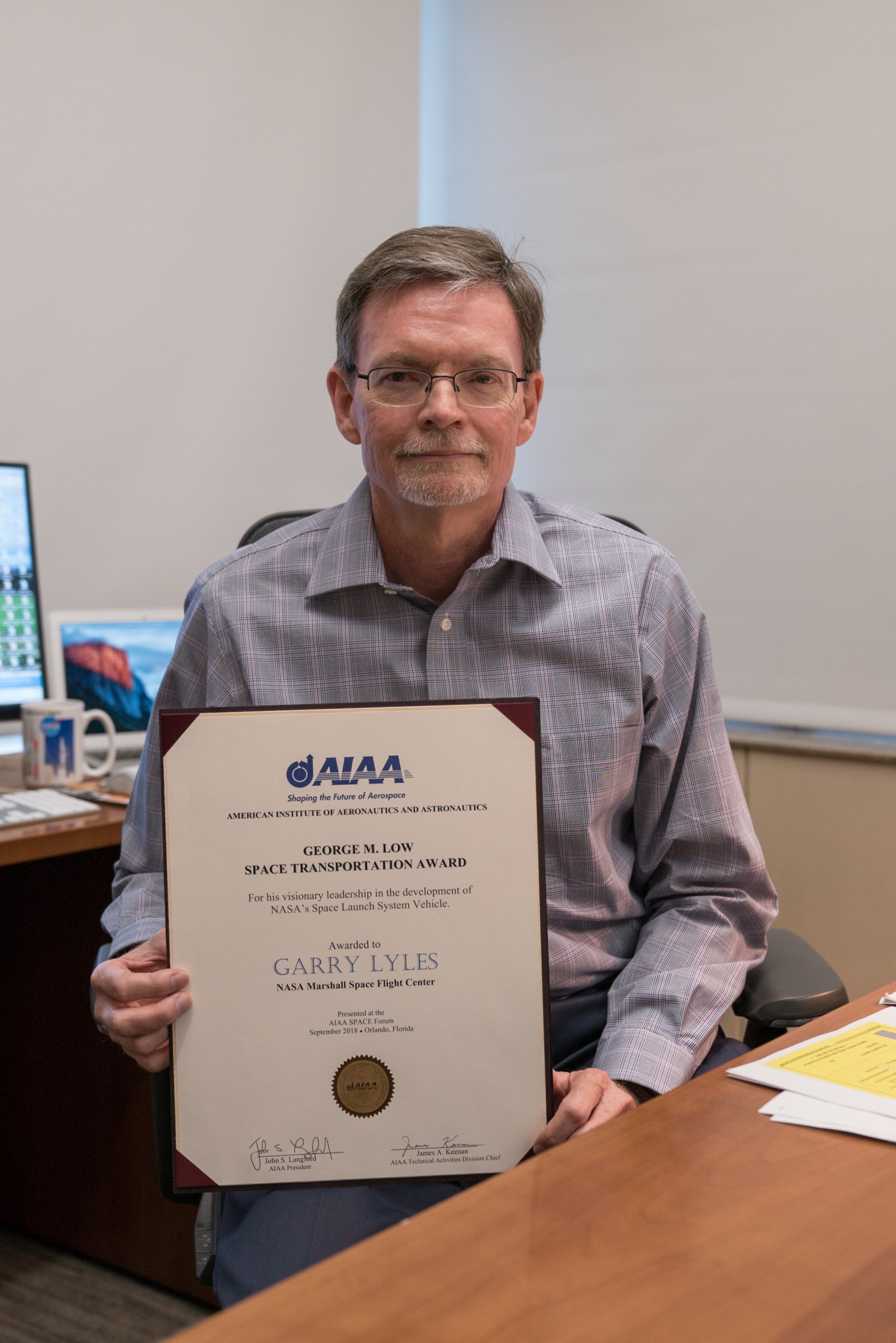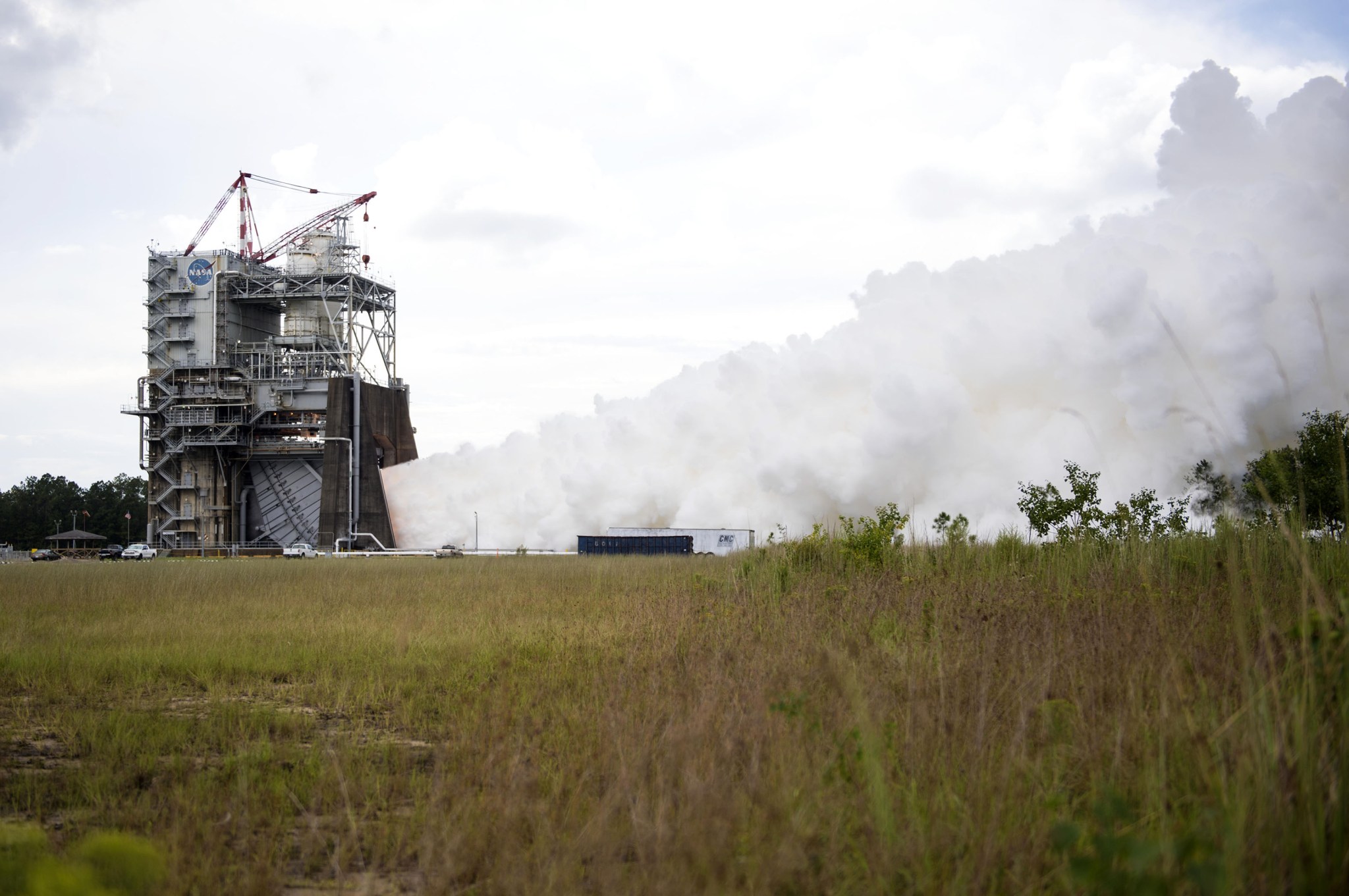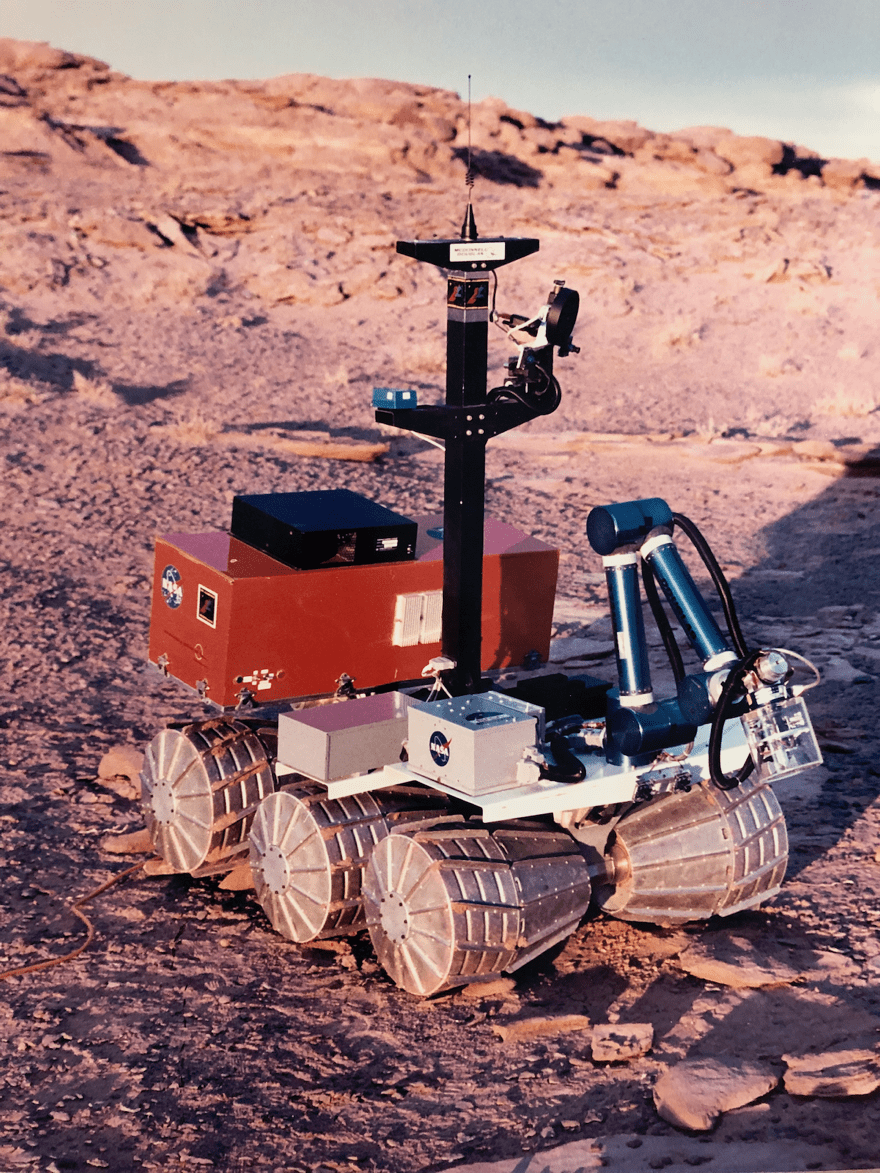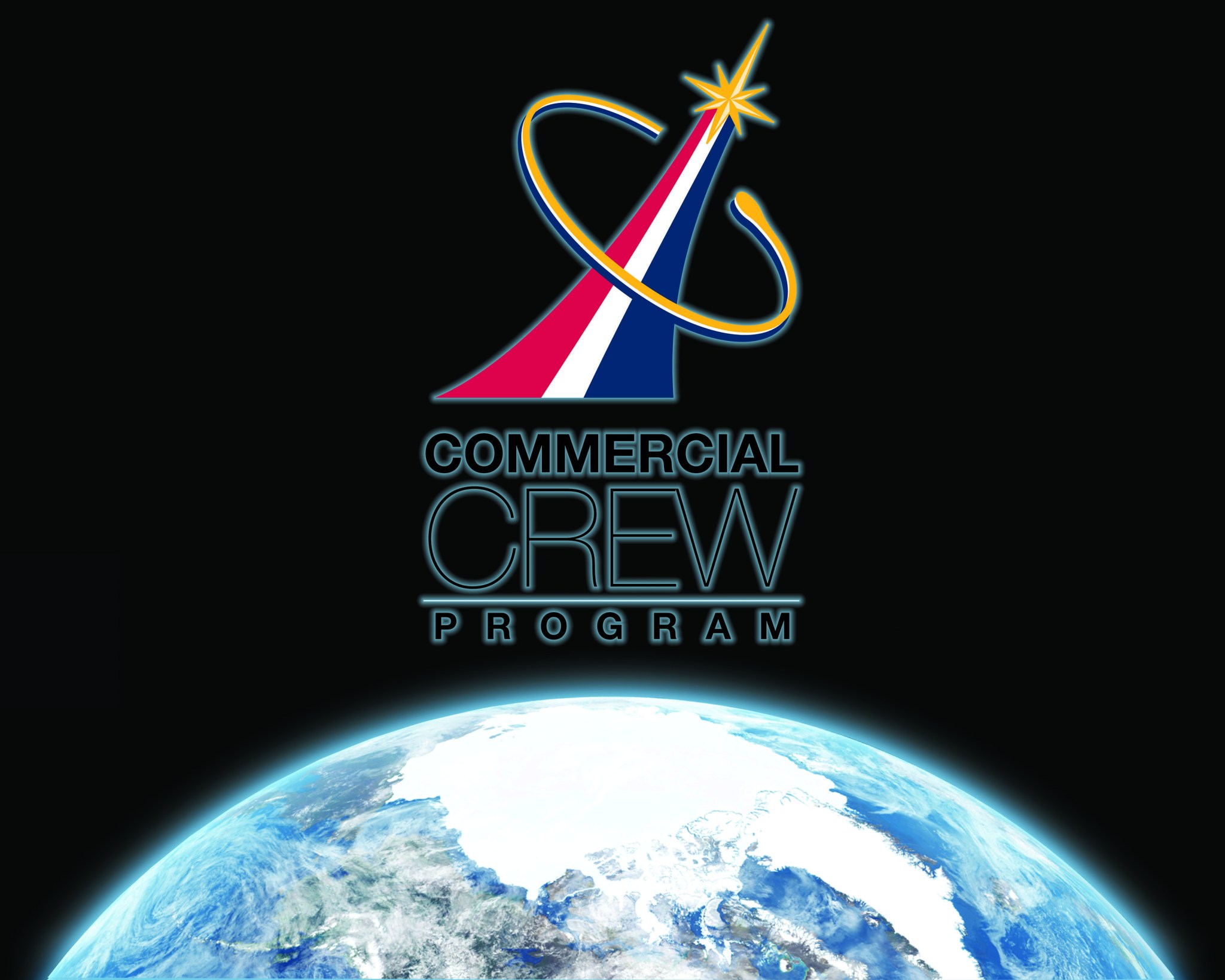In This Week’s Star
- NASA Marshall Panel Discusses ‘Sixty Years of Smoke and Fire’
- SLS Chief Engineer Driven by ‘Challenge’ of Building Rocket
- NASA Right on Schedule with RS-25 Flight Controller Test
- ‘First Man’ Pre-Screening Available for Marshall Team Members
- Making Head or Tail of a Galactic Landscape
- Racin’ the Station Challenges Athletes at Marshall
- Community College Students Tackle Robotics, Leadership at NASA Workshop
- Kids 4-12 Challenged to Submit Original Art for NASA Commercial Crew Calendar
- This Week in NASA History: STS-41G Launches – Oct. 5, 1984
- RS-25 Engine Test and Cargo Arrival at International Space Station Highlighted on ‘This Week @NASA’
- Obituaries
NASA Marshall Panel Discusses ‘Sixty Years of Smoke and Fire’
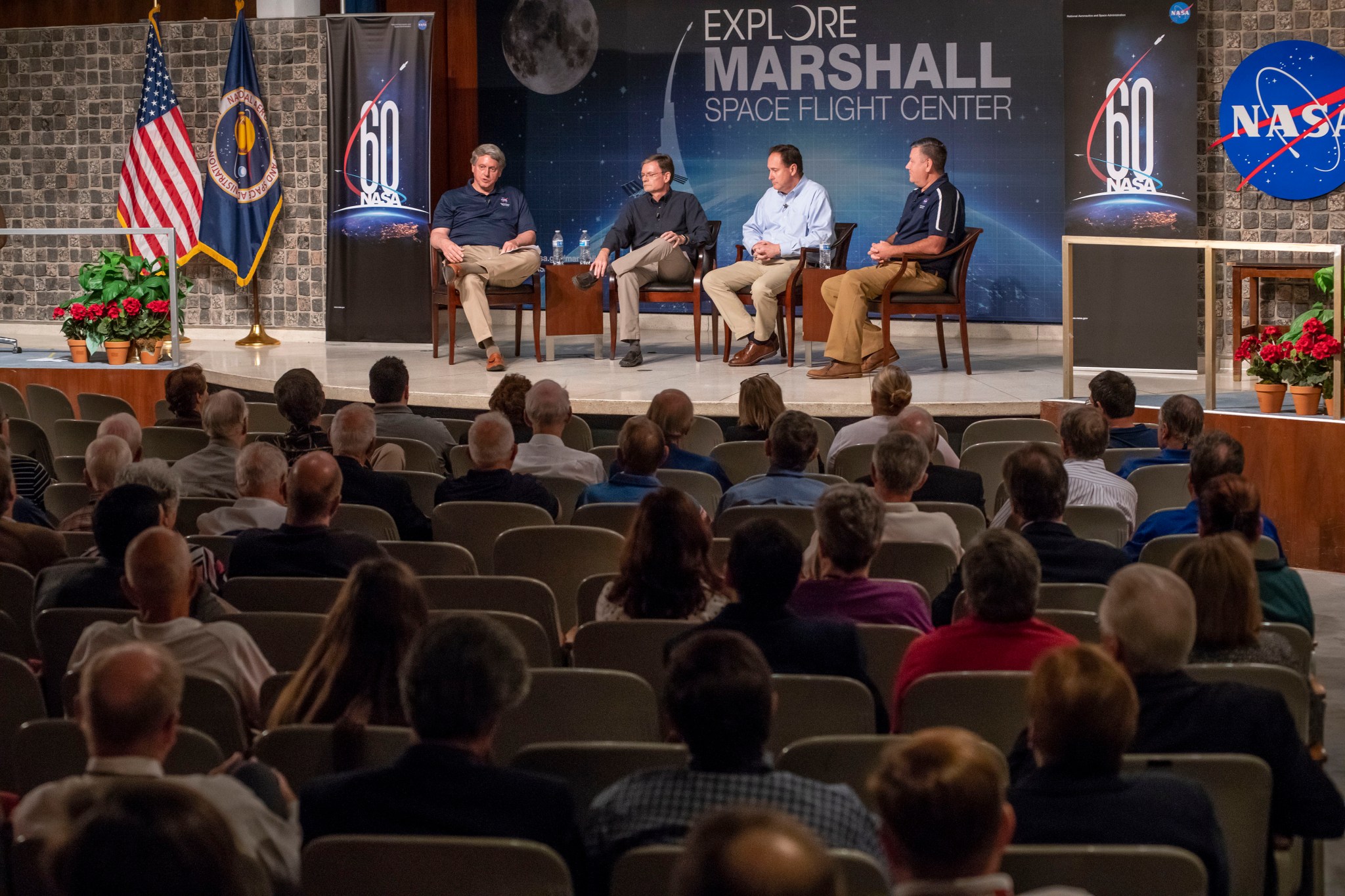
During a Sept. 27 event commemorating NASA’s 60th Anniversary, Marshall Space Flight Center team members listen to a panel discussion themed, “Sixty Years of Smoke and Fire: Igniting Human Space Exploration through Engine Testing at Marshall and Stennis.” Gene Goldman, former Marshall center acting director, left, moderated the panel, which included from left, Garry Lyles, NASA Space Launch System program chief engineer; Robert Lightfoot Jr., former NASA acting administrator; and Patrick Scheuermann, former Marshall center director. Marshall team members may view the panel discussion on ExplorNet. From 2018 through 2022, NASA is marking a series of important milestones – the 60th anniversary of the agency’s founding by Congress in 1958 and the 50th anniversary of the Apollo missions that put a dozen Americans on the Moon between July 1969 and December 1972. Marshall will celebrate its own 60th anniversary on July 1, 2020. (NASA/Fred Deaton)
SLS Chief Engineer Driven by ‘Challenge’ of Building Rocket
Space Launch System Chief Engineer Garry Lyles has received the 2018 American Institute of Aeronautics and Astronautics George M. Low Award for Space Transportation. AIAA cited Lyles’ “visionary leadership” in the development of NASA’s SLS rocket.
“Building the world’s most powerful rocket has been challenging,” Lyles said. “There is tremendous complexity in how all the pieces and parts of the Space Launch System work together. What I’ve found is a lot of what makes the rocket work is not just the physics. It’s the people. I feel like this award is for the whole SLS team.”
Lyles has served as the SLS chief engineer at NASA’s Marshall Space Flight Center since the program’s beginning in the fall of 2011, guiding the rocket through both its preliminary and critical design reviews. Now, hardware is being built for the first and second flight.
“It’s an honor to be part of the team that is designing and building a rocket that is powerful enough to take humans beyond the Moon, farther than they’ve ever traveled in deep space,” Lyles said.
Lyles first became fascinated with human spaceflight during the Saturn V days. As a 10-year-old boy, he came to Marshall with his dad and uncle for an open house and learned about America’s first landings on the Moon.
That day, as S1 stage engines ignited every hour in the test stand, something ignited in that little boy, as well — a dream to one day work “at one of the coolest places” he’d ever been. Today, he’s living that dream.
“It’s funny – at that open house all those years ago, I didn’t think much about being an engineer, but Marshall sure did impress me as an exciting place to work,” Lyles recalls. “Later on, when I was in high school, I had a couple of friends who wanted to be engineers. The only thing we knew then was engineers designed things, and that’s what we wanted to do. We wanted to create things.”
“We all decided to go to engineering school. I took one of those career aptitude tests, and according to it, the probability of me making passing grades in engineering was relatively low. But that just made me want it more. I said, ‘You know what? I’ll show you.’”
And “show” he has, graduating from the University of Alabama with a degree in mechanical engineering and working for NASA for 42 years.
“I was lucky enough to start working for NASA when a lot of the Saturn vehicle designers were still here,” Lyles remembers. “I was in a very unique situation where I was the one of the few young guys around, and we were able to learn from very experienced engineers who had been on the front end of the Saturn design.”
“The other good part of my career is that I came in near the front end of the Space Shuttle Development Program,” he added. “I had one particular engineer who was my primary mentor — Tom Winstead — a very, very smart engineer. In working with him for eight years, I not only learned how to be a better engineer, but I also learned how to communicate much better. I learned a lot of patience in communication, which helps me tremendously in my current position.”
As chief engineer, Lyles integrates the different elements of the SLS into a design that will fly successfully and safely beyond low-Earth orbit. This includes the boosters, engines, core stage and Interim Cryogenic Propulsion Stage, which have been or are currently being built for Exploration Mission-1 (EM-1). During EM-1, SLS and Orion will demonstrate the critical backbone capabilities that will carry humans to the Moon and farther into space than ever before on a variety of missions with increasing complexity.
Lyles is also guiding the design and development of even more powerful configurations of SLS that will provide unprecedented power and volume to carry the large pieces of hardware needed to build the Gateway and other long-term infrastructure at the Moon and, later, for human missions to Mars.
“As far as my career goes, I’ve been so fortunate.” Lyles said. “I’ve always wanted to be in the middle of the biggest project at the center, and then carry it all the way through flight. When we see SLS loft astronauts to the Moon, that will probably be my proudest moment.”
NASA Right on Schedule with RS-25 Flight Controller Test
NASA stayed right on schedule with the third in a series of scheduled RS-25 rocket engine tests at Stennis Space Center Sept. 25. The successful hot fire of RS-25 developmental engine No. 0525 met all test objectives and featured several key elements, most notably an acceptance test of an engine flight controller for use by NASA’s new Space Launch System rocket. The hot fire also represented the seventh test of a 3D-printed pogo accumulator and the third test of a main combustion chamber fabricated using a bonding technique designed to save time and money. (NASA)
‘First Man’ Pre-Screening Available for Marshall Team Members
NASA Marshall Space Flight Center team members will have an opportunity to watch a pre-release screening of the movie, “First Man,” Oct. 11 at 5 p.m. in the U.S. Space & Rocket Center’s National Geographic Theatre.
Tickets for this event will be distributed to Marshall team members through a random drawing. To participate in the drawing, visit the Marshall Exchange Gift Shop in Building 4203 and complete an entry slip before 12 p.m. Oct. 9. The Exchange Office will notify winners via email after names are drawn on Oct. 9.
Due to the limited number of tickets, only one non-transferrable ticket will be given to each recipient. Winners unable to attend should return the ticket to the Exchange Office. It will be awarded to the next person whose name is drawn.
Starring Ryan Gosling and Claire Foy, First Man is about the life of the former NASA astronaut Neil Armstrong from 1961-1969, on his journey to become the first human to walk on the Moon. The film explores the sacrifices and costs on Armstrong, his family and the entire nation during one of the most dangerous missions in the history of space travel.
Making Head or Tail of a Galactic Landscape
Astronomers have used data from NASA’s Chandra X-ray Observatory to capture a dramatic image of an enormous tail of hot gas stretching for more than a million light years behind a group of galaxies that is falling into the depths of an even-larger cluster of galaxies. Discoveries like this help astronomers learn about the environment and conditions under which the universe’s biggest structures evolve.
Galaxy clusters are the largest structures in the universe held together by gravity. While galaxy clusters can contain hundreds or even thousands of individual galaxies, the lion’s share of mass in a galaxy cluster comes from hot gas, which gives off X-rays, and unseen dark matter. How did these cosmic giants get to be so big?
This new image shows one way: the capture of galaxies as they are drawn in by the extraordinarily powerful gravity of a galaxy cluster. In the left panel, a wide-field view of the cluster, called Abell 2142, is seen. Abell 2142 contains hundreds of galaxies embedded in multi-million-degree gas detected by Chandra (purple). The center of the galaxy cluster is located in the middle of the purple emission, in the lower part of the image. Only the densest hot gas is shown here, implying that less dense gas farther away from the middle of the cluster is not depicted in the purple emission.
A bright X-ray tail located in the upper left of the image is aiming straight for Abell 2142. The right panel contains a closer view of this tail. A galaxy group containing four bright galaxies is near the “head” while the “tail” extends off to the upper left. Galaxy groups, as defined by astronomers, contain a handful to a few dozen galaxies, as opposed to much more populous galaxy clusters. The direction of the tail and the sharp leading edge of the hot gas around the galaxy group, identified in the labeled version, shows that the group is falling almost directly toward the center of Abell 2142. A close-up view of the four bright galaxies — named G1, G3, G4 and G5 — is shown as an optical and X-ray image. The galaxy G2 is a background object, rather than a member of the galaxy group.
As the group of galaxies falls into Abell 2142, some of the hot gas is stripped off, much like leaves from a tree in the fall during a strong gust of wind. As the gas gets stripped off, it forms into a straight and relatively narrow tail that extends for some 800,000 light years. The shape of the tail suggests that magnetic fields draped around it are acting like a shield to contain the gas. Beyond about a million light years, the tail flares and becomes irregular. This may mean the turbulence in the galaxy cluster’s hot gas is stronger in that area, helping to break down the effect of the magnetic shield.
The lower side of the tail flares out more than the upper side. This may be caused by a previous asymmetry in the hot gas in the galaxy group. Such an asymmetry could result from an outburst generated by a supermassive black hole in one of the galaxies in the group, or from mergers between galaxies in the group. Such events could lead to some parts of the galaxy group’s gas being stripped more easily than others.
The new Chandra data also confirm that two of four bright galaxies in the group, G3 and G4, contain rapidly growing, supermassive black holes. The two corresponding X-ray sources are closely overlapping in the Chandra image.
A paper describing the results, led by Dominique Eckert of the University of Geneva in Switzerland, appeared in the Astronomy & Astrophysics journal. NASA’s Marshall Space Flight Center manages the Chandra program for NASA’s Science Mission Directorate. The Smithsonian Astrophysical Observatory in Cambridge, Massachusetts, controls Chandra’s science and flight operations.
Racin’ the Station Challenges Athletes at Marshall
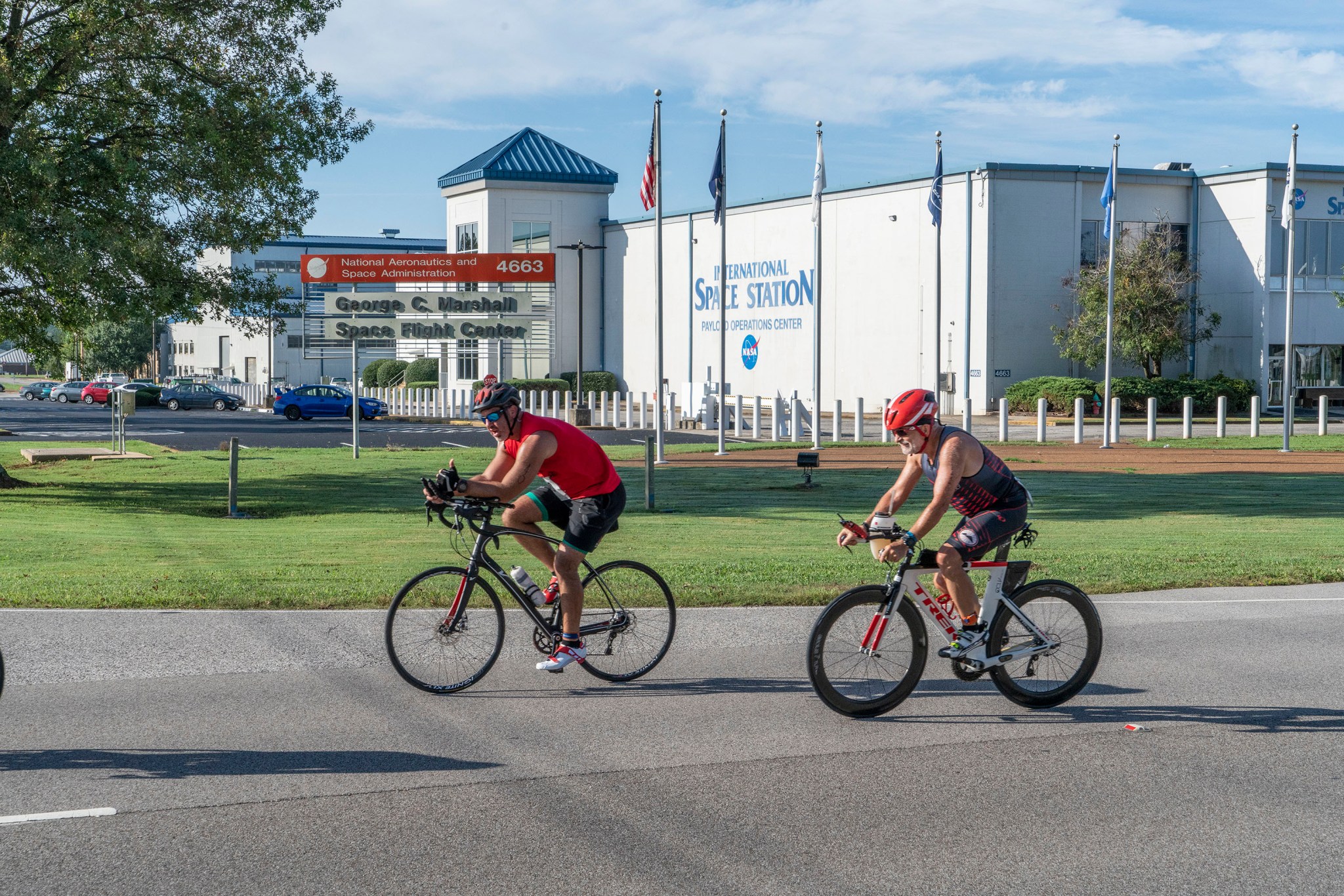
More than 200 athletes rendezvoused at NASA’s Marshall Space Flight Center Sept. 29 for the seventh annual “Racin’ the Station” duathlon. As the International Space Station flew over the Pacific Ocean, competitors launched off the start line to begin the 18-mile course — consisting of a 3.14-kilometer run, a 25-kilometer bike ride and one final 3.14-kilometer run. The goal is to complete the course before the space station completes its orbit around Earth 91 minutes, 12 seconds later. The duathlon, hosted by Huntsville Team Rocket Tri Club, is held at Marshall each year. Proceeds from the event fund the Marshall Association’s scholarship fund. (Credit: NASA/Fred Deaton)

Racers keep track of whether they’re beating the station by tracking the designated pace setter, Stan the Station, second from right, who wore race apparel resembling an astronaut suit, complete with helmet. Those who finished the course before the station completed its orbit were awarded a commemorative “I Beat the Station!” cup. 109 of the 171 individual competitors and 23 of the 32 two-person relay teams beat the station. (Credit: NASA/Fred Deaton)
The transition area for Racin’ the Station — where the racers transfer to and from the biking and running sections of the course — was beside a life-sized drawing of NASA’s Space Launch System rocket and an RS-25 engine. (Credit: NASA)
Community College Students Tackle Robotics, Leadership at NASA Workshop
By Rick Smith
Whether they’re devising robotic rovers to explore other worlds or networking with veteran agency professionals, students in the NASA Community College Aerospace Scholars workshop at NASA’s Marshall Space Flight Center may be honing lifetime careers crucial to America’s space program.
Most of the 36 students who took part in Marshall’s fall workshop Sept. 25-28 represented minority-serving institutions around the country. Many are pursuing STEM studies: science, technology, engineering and mathematics. Event organizers and guest speakers from across Marshall said the program helps build on those studies to mold aspiring collegians into the engineers and explorers of tomorrow.

“Your point of view is important,” Monsi Roman, a NASA microbiologist who heads NASA’s Centennial Challenges technology development program at Marshall, told students at the Sept. 25 kickoff. “You can make a difference — in space and here on Earth. Take a job doing something you love, and you may find you’re amazing at it.”
Now in its seventh year at Marshall, the program first challenges interested students to take a five-week, web-based course about NASA’s missions. Current subjects include next-generation human spaceflight, science on the International Space Station and exploration of the Mars. Courses are regularly updated to integrate new programs and mission goals, such as NASA’s Moon to Mars initiative.
Based on their course results, students are competitively selected for a workshop at one of 10 NASA field centers. Applicants must be U.S. citizens, at least 18 years old, high school graduates or the equivalent and enrolled at the time in a community college.
The latest Marshall workshop participants hailed from 23 schools in Alabama, Arizona, California, Colorado, Mississippi and Texas. They worked in four teams, each mentored by a Marshall team member, mocking up bids for a NASA contract to build a planetary rover. Each team created a proposal and marketing campaign, and built working prototypes using Lego® MindStorm EV3 robots. Finally, they presented their rovers to a NASA panel — including aerospace engineers well-versed in rover engineering.
The students also listened to presentations about NASA programs; toured Marshall laboratories and engineering facilities and the U.S. Space & Rocket Center; and met some of the agency’s brightest minds.
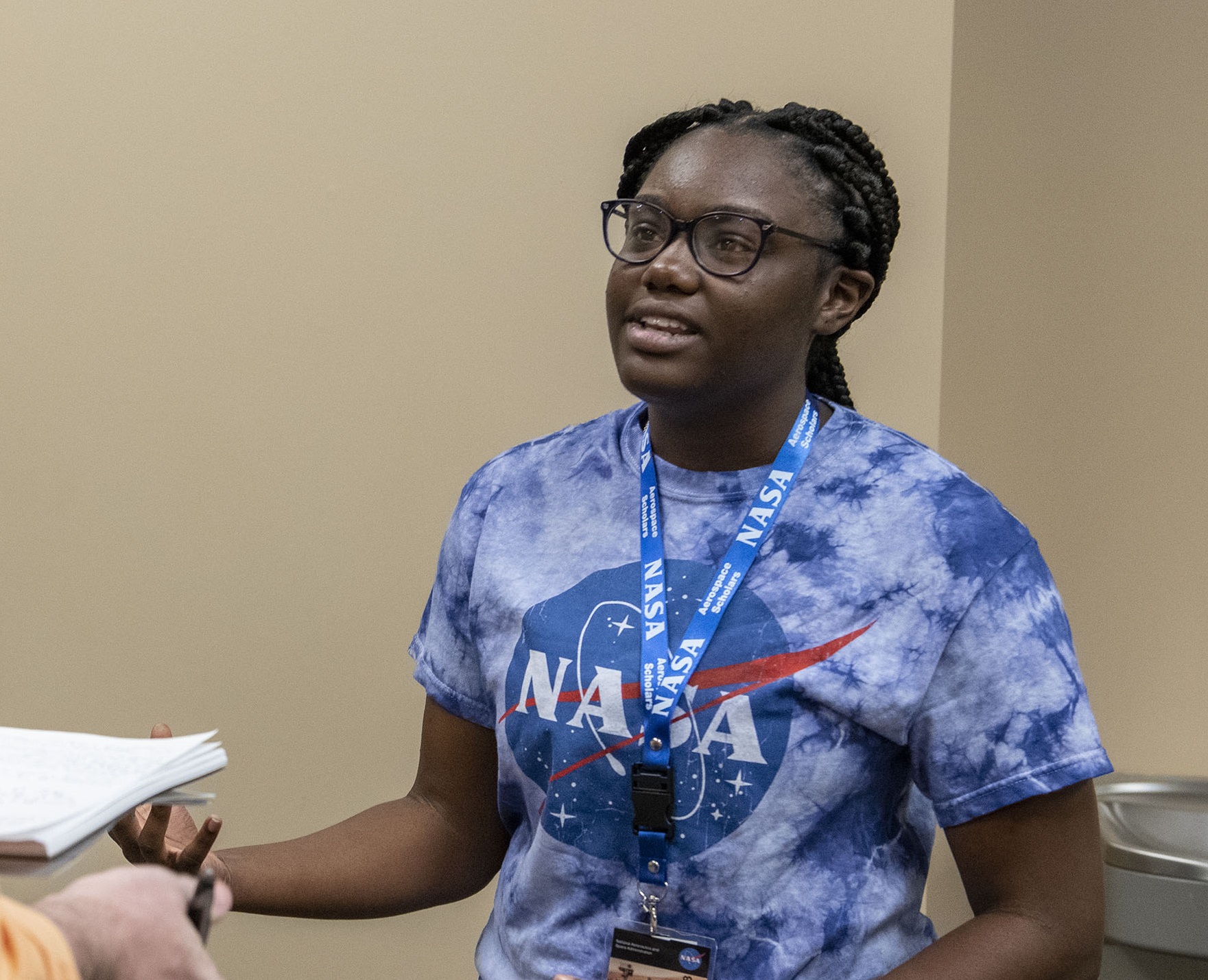
“Team members from all over Marshall, including NASA Scholars program alumni, talked with students, sharing their own stories, answering questions and demonstrating that NASA careers are attainable, desirable and truly rewarding,” said Marshall education specialist Maria Chambers.
Workshop participant Myeshia Jenkins, a psychology student at Lawson State Community College in Birmingham, Alabama, said she was intimidated at first — until she began talking with fellow students and NASA workers. “It’s exciting to be part of such a diverse mix of people and backgrounds, all working together for common goals,” she said. “There’s so much more to NASA than I imagined.”
Alexander Beltzer-Sweeney, a physics student at San Diego Mesa College in California, agreed. He mentors and tutors STEM students, and applied to the program based on endorsements from past participants. “Seeing their enthusiasm, I realized the workshop could enhance my ability to help career-minded STEM students achieve their goals,” he said. “I look forward to telling others about the opportunities here at NASA and Marshall.”
That self-sustaining recruitment pipeline is a key element of the program, Chambers said. So is the power of four days immersed in the NASA culture. “The best part is seeing students transformed by their short week here,” she said. “It’s inspiring to them — and that’s always inspiring to us.”
The NASA Community College Aerospace Scholars program is sponsored by NASA’s Minority University Research and Education Project and administered by NASA’s Johnson Space Center, which founded the program in 2012.
Smith, an ASRC Federal/Analytical Services employee, supports the Office of Strategic Analysis & Communications.
Kids 4-12 Challenged to Submit Original Art for NASA Commercial Crew Calendar
The NASA Commercial Crew Program has launched a calendar design contest, challenging children aged 4-12 to submit original artwork about exploring deep space or working on the International Space Station.
The winning entries will appear in the Commercial Crew Program’s 2019 calendar, featuring different aspects of living and working in space. It will include supplemental education materials to help kids all over the world learn more about the challenges and successes of science and exploration beyond Earth’s orbit.
The contest is open through Oct. 17. Complete rules and entry instructions are available here. Parental permission is required for all entrants.
NASA’s Commercial Crew Program is a partnership between the U.S. space program and commercial aerospace companies to develop and fly human space transportation systems capable of carrying crews to low-Earth orbit and the space station.
This Week in NASA History: STS-41G Launches – Oct. 5, 1984
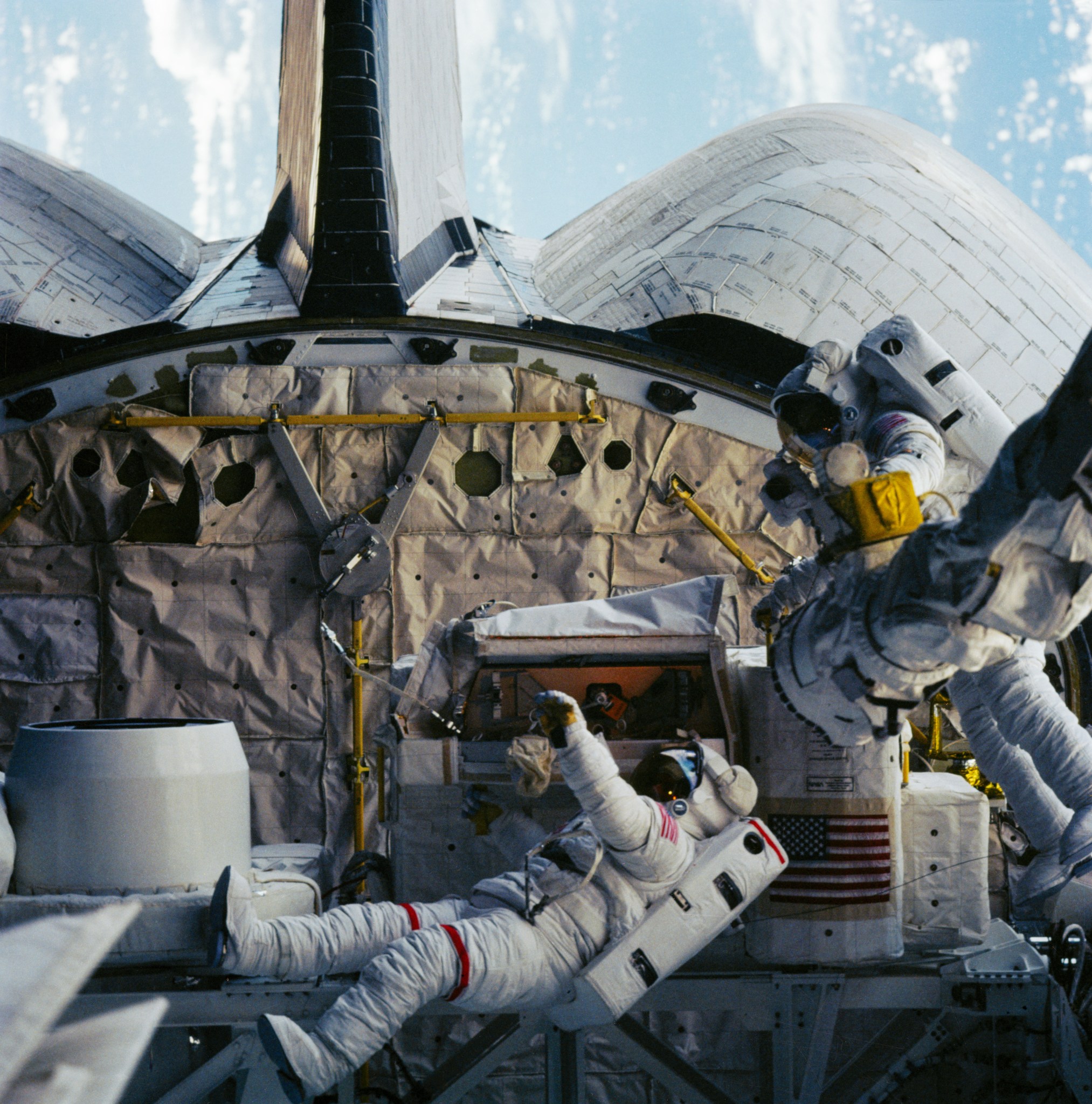
This week in 1984, the space shuttle Challenger, mission STS-41G, launched from NASA’s Kennedy Space Center to deliver the Earth Radiation Budget Satellite to orbit. Components of the ORS — Orbital Refueling System — were connected, demonstrating it is possible to refuel satellites in orbit. This was the first flight to include two female astronauts, Sally Ride and Kathryn Sullivan. Here, astronauts David Leestma, left, and Sullivan work at the ORS in the aft end of the cargo bay. This was the first time an American woman walked in space. The NASA History Program is responsible for generating, disseminating, and preserving NASA’s remarkable history and providing a comprehensive understanding of the institutional, cultural, social, political, economic, technological and scientific aspects of NASA’s activities in aeronautics and space. For more pictures like this one and to connect to NASA’s history, visit the Marshall History Program’s webpage. (NASA)
RS-25 Engine Test and Cargo Arrival at International Space Station Highlighted on ‘This Week @NASA’
The latest RS-25 engine test and the arrival of the Japanese cargo spacecraft to the International Space Station are featured in the latest edition of “This Week @NASA,” a weekly video program broadcast nationwide on NASA-TV and posted online.
On Sept. 25, engineers at NASA’s Stennis Space Center successfully conducted the third in a series of scheduled RS-25 rocket engine hot fire tests for NASA’s Space Launch System Program. The hot fire tested several key elements, including a flight controller that will help the engine communicate with the SLS rocket. SLS will use four RS-25s to launch NASA’s Orion spacecraft on missions to deep space destinations, including the Moon and Mars.
On Sept. 27, the crew of the space station received more than five tons of supplies, spare parts and experiments with the arrival of Japan’s HTV-7 cargo spacecraft. HTV-7 launched to the station five days earlier from the Tanegashima Space Center in southern Japan.
View this and previous episodes at “This Week @NASA” on NASA’s YouTube page.
Obituaries
David J. Percival, 71, of Madison, Alabama, died Sept. 16. He retired from the Marshall Center in 2010 as a financial program specialist. He is survived by his wife, Debbie Percival.

